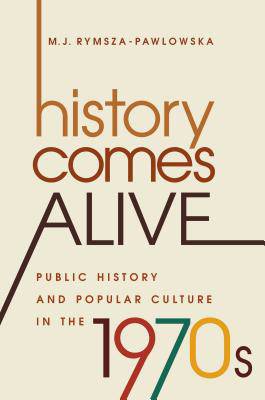
Door een staking bij bpost kan je online bestelling op dit moment iets langer onderweg zijn dan voorzien. Dringend iets nodig? Onze winkels ontvangen jou met open armen!
- Afhalen na 1 uur in een winkel met voorraad
- Gratis thuislevering in België vanaf € 30
- Ruim aanbod met 7 miljoen producten
Door een staking bij bpost kan je online bestelling op dit moment iets langer onderweg zijn dan voorzien. Dringend iets nodig? Onze winkels ontvangen jou met open armen!
- Afhalen na 1 uur in een winkel met voorraad
- Gratis thuislevering in België vanaf € 30
- Ruim aanbod met 7 miljoen producten
Zoeken
€ 137,95
+ 275 punten
Uitvoering
Omschrijving
During the 1976 Bicentennial celebration, millions of Americans engaged with the past in brand-new ways. They became absorbed by historical miniseries like Roots, visited museums with new exhibits that immersed them in the past, propelled works of historical fiction onto the bestseller list, and participated in living history events across the nation. While many of these activities were sparked by the Bicentennial, M. J. Rymsza-Pawlowska shows that, in fact, they were symptomatic of a fundamental shift in Americans' relationship to history during the 1960s and 1970s.
For the majority of the twentieth century, Americans thought of the past as foundational to, but separate from, the present, and they learned and thought about history in informational terms. But Rymsza-Pawlowska argues that the popular culture of the 1970s reflected an emerging desire to engage and enact the past on a more emotional level: to consider the feelings and motivations of historic individuals and, most importantly, to use this in reevaluating both the past and the present. This thought-provoking book charts the era's shifting feeling for history, and explores how it serves as a foundation for the experience and practice of history making today.
For the majority of the twentieth century, Americans thought of the past as foundational to, but separate from, the present, and they learned and thought about history in informational terms. But Rymsza-Pawlowska argues that the popular culture of the 1970s reflected an emerging desire to engage and enact the past on a more emotional level: to consider the feelings and motivations of historic individuals and, most importantly, to use this in reevaluating both the past and the present. This thought-provoking book charts the era's shifting feeling for history, and explores how it serves as a foundation for the experience and practice of history making today.
Specificaties
Betrokkenen
- Auteur(s):
- Uitgeverij:
Inhoud
- Aantal bladzijden:
- 258
- Taal:
- Engels
- Reeks:
Eigenschappen
- Productcode (EAN):
- 9781469633855
- Verschijningsdatum:
- 19/11/2017
- Uitvoering:
- Hardcover
- Formaat:
- Genaaid
- Afmetingen:
- 156 mm x 234 mm
- Gewicht:
- 576 g

Alleen bij Standaard Boekhandel
+ 275 punten op je klantenkaart van Standaard Boekhandel
Beoordelingen
We publiceren alleen reviews die voldoen aan de voorwaarden voor reviews. Bekijk onze voorwaarden voor reviews.











